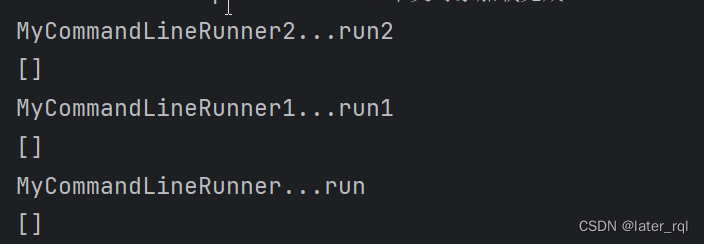热门标签
热门文章
- 1秋招总结!面试攻略!看完就知道面试官给我200W年薪offer一点也不冲动!_面试问如果有200w会做什么
- 2python中的常见语法讲解_python 语法解析
- 3一维卡尔曼滤波器原理及应用(含C代码)_c语言卡尔曼滤波的详解
- 4机械狗控制算法_机器狗控制算法
- 5某程序员吐槽:前端开发被哄抢,专科学历能进大厂;客户端开发找工作难如登天,985本硕拿不到一个offer!...
- 6Python使用lxml模块抓取数据_etree 获取数据
- 7【华为OD机试真题 C++语言】159、星际篮球争霸赛 | 机试真题+思路参考+代码解析
- 8Mistral AI CEO宣布于2024年开源GPT-4级别模型_mistral openorca vs mistral instruct
- 9VOS文件分析_vos. . . .. .0 00 000 0000 0 0 0 0 0
- 10ubuntu20.04安装mysql8_ubuntu 20.4安装mysql 8
当前位置: article > 正文
SpringBoot学习笔记四
作者:凡人多烦事01 | 2024-04-11 19:33:27
赞
踩
SpringBoot学习笔记四
1. SpringBoot监听器
 上述的四种监听器按照使用的方式可以分为两种:
上述的四种监听器按照使用的方式可以分为两种:
1.1 无需配置
- CommandLineRunner
- ApplicationRunner:还需要写一个有参的构造函数
@Component
public class MyCommandLineRunner implements CommandLineRunner {
@Override
public void run(String... args) throws Exception {
System.out.println("MyCommandLineRunner...run");
System.out.println(Arrays.asList(args));
}
}
- 1
- 2
- 3
- 4
- 5
- 6
- 7
- 8
@Component
public class MyApplicationRunner implements ApplicationRunner {
@Override
public void run(ApplicationArguments args) throws Exception {
System.out.println("MyApplicationRunner...run");
System.out.println(Arrays.asList(args.getSourceArgs()));
}
}
- 1
- 2
- 3
- 4
- 5
- 6
- 7
- 8
- 9
项目启动时,会自动执行上述的内容。
1.1.1 CommandLineRunner使用
日常开发中有可能需要实现项目启动后执行的功能,比如特殊数据处理,权限控制、缓存预热等
按照使用可以分为单个实现类和多个实现类,
- 单个实现类如上面,无需指定执行顺序;
- 多个实现类如果需要指定执行顺序,需要使用@Order注解来表明执行顺序
@Component
@Order(3)
public class MyCommandLineRunner implements CommandLineRunner {
@Override
public void run(String... args) throws Exception {
System.out.println("MyCommandLineRunner...run");
System.out.println(Arrays.asList(args));
}
}
- 1
- 2
- 3
- 4
- 5
- 6
- 7
- 8
- 9
@Component
@Order(2)
public class MyCommandLineRunner1 implements CommandLineRunner {
@Override
public void run(String... args) throws Exception {
System.out.println("MyCommandLineRunner1...run1");
System.out.println(Arrays.asList(args));
}
}
- 1
- 2
- 3
- 4
- 5
- 6
- 7
- 8
- 9
- 10
@Component
@Order(1)
public class MyCommandLineRunner2 implements CommandLineRunner {
@Override
public void run(String... args) throws Exception {
System.out.println("MyCommandLineRunner2...run2");
System.out.println(Arrays.asList(args));
}
}
- 1
- 2
- 3
- 4
- 5
- 6
- 7
- 8
- 9
执行结果:
 注解@Order的执行级别是按照1最优先执行,后面依次执行。
注解@Order的执行级别是按照1最优先执行,后面依次执行。
1.1.2 ApplicationRunner的使用
spring容器启动完成之后,就会紧接着执行这个接口实现类的run方法。
run方法的参数: ApplicationArguments可以获取到当前项目执行的命令参数。(比如把这个项目打成jar执行的时候,带的参数可以通过ApplicationArguments获取到)
若有多个代码段需要执行,可用@Order注解设置执行的顺序。
1.1.3 CommandLineRunner与ApplicationRunner的区别
- CommandLineRunner的方法参数是原始的参数,未做任何处理;
- ApplicationRunner的参数为ApplicationArguments对象,是对原始参数的进一步封装。
1.2 需要创建META-INF文件,并在其中创建spring.factories,配置相关的信息
- ApplicationContextInitialize
- SpringApplicationRunListener
1.2.1 ApplicationContextInitialize
目前不去细研究,有兴趣可以看这篇博客:Springboot扩展点之ApplicationContextInitializer
1.2.2 SpringApplicationRunListener
详细内容看这篇博客:SpringApplicationRunListeners 监听器执
声明:本文内容由网友自发贡献,不代表【wpsshop博客】立场,版权归原作者所有,本站不承担相应法律责任。如您发现有侵权的内容,请联系我们。转载请注明出处:https://www.wpsshop.cn/w/凡人多烦事01/article/detail/406983
推荐阅读
相关标签


